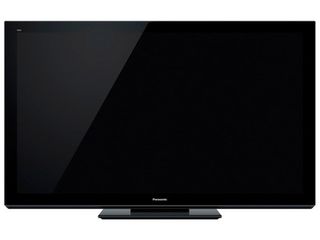Why you can trust TechRadar

The differences between this top-end plasma TV and those lower down the pecking order at Panasonic are initially merely aesthetic.
The Panasonic TX-P50VT30B's silver trimmed single glass pane design aside, the two pairs of 3D glasses in the box, a spruced-up remote control with backlighting and a slim 37mm depth - thinner than most mid-range LED TVs, but chubbier than flagship LED TVs - make this a standout screen in Panasonic's store cupboard.
To reach that slim depth has meant using a few proprietary ins and outs and an unusual connections layout, which means a plethora of adaptors in the box. A recessed side panel contains the meat; four HDMI inputs, a USB port, SD card slot and a Common Interface module.
On a rear panel are adaptor points for component video, composite video, Scart and analogue audio in and out, alongside points for Freeview and Freesat, and Ethernet LAN.
Unusually, there's a separate section higher up on the TV's backside that's home to two further USB slots, one of which is designed to take a Skype camera, which Panasonic sells separately.
Although almost all of the brand's output is fitted with a Freeview HD tuner, the Panasonic TX-P50VT30B comes with an additional Freesat HD version. It's good news for those who need it, although rather niche; of more worth is the bigscreen TV's ability to record broadcasts straight from live TV, as well as timed from the EPG to a USB-connected hard drive.
It's also a boon to find digital file support from a USB flash drive as well as from a DLNA-compatible networked PC (or Mac if you install a UPnP client), the latter enabled by an integrated Wi-Fi module.
Wi-Fi makes placement of the Panasonic TX-P50VT30B so, so much easier and will enable full use of the TV's impressive online dimension.
That Wi-Fi brain is also used to hook up the Panasonic TX-P50VT30B to broadband for Viera Connect duties. This online platform is now becoming a slick and powerful rival to the industry leaders - Samsung's stuffed, but rather amateur-looking Smart Hub, and Sony's arguably peerless Bravia Internet Video.
Viera Connect comprises eight dynamic app icons around a bigger, central window that plays, with audio, whatever live input you want - typically a Blu-ray movie or Freeview TV show. That makes it feel part of the TV as a whole rather than a separate service, but it's slightly hampered by the need for several screens; a bit like all those apps on a smartphone that can stretch to too many pages.
At least it can be customised, although most of the services are genuinely useful. Acetrax, YouTube, BBC iPlayer, Skype (if you buy a camera/microphone), Facebook, Eurosport, Viera Connect Market and links to set up are on the default home screen. The second page is less essential, with Twitter joined by Screenrush, Euronews, Picasa, UStream, SHOUTcast and Dailymotion. Aupero, Chess Challenge, CNBC Real-Time, BBC News live feed and a weather service can be found elsewhere.
Image quality is bolstered largely by the use of a NeoPlasma panel sporting Infinite Black Pro, which represents something akin to the pinnacle of plasma innovation (as we'll see). It also has a High Contrast Filter Pro (to boost brightness in a daytime environment) and 600Hz Sub-Field Drive motion processing.
Jamie is a freelance tech, travel and space journalist based in the UK. He’s been writing regularly for Techradar since it was launched in 2008 and also writes regularly for Forbes, The Telegraph, the South China Morning Post, Sky & Telescope and the Sky At Night magazine as well as other Future titles T3, Digital Camera World, All About Space and Space.com. He also edits two of his own websites, TravGear.com and WhenIsTheNextEclipse.com that reflect his obsession with travel gear and solar eclipse travel. He is the author of A Stargazing Program For Beginners (Springer, 2015),

'A whole new generation of displays': researchers develop RGB LED out of miracle material perovskite, paving the way for self sensing, solar powered displays — but its hour-long service life needs to be improved first

Quordle today – hints and answers for Sunday, April 21 (game #818)

NYT Strands today — hints, answers and spangram for Sunday, April 21 (game #49)

